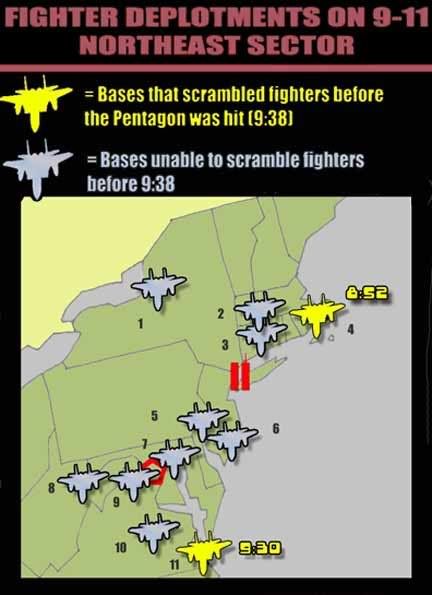After this news was reported, the official stance changed. On the 18th, NORAD published their final initial timeline, including the Otis scramble time as 8:52, and an additional scramble of fighters from Langley Air Force Base at 9:30, ceding two scrambles before the Pentagon was hit. This timeline changed yet again in 2004 as the 9/11 Commission released its findings. Most of the facts that follow are from this newer version of events (the scrambles just mentioned are agreed on in both versions).
At the time of the attacks, only fourteen fighters were routinely kept on ready and alert status across the US mainland. These were deployed and scrambled in pairs, so these fighters represented only seven actual deployments. Nearly all reported pre-9/11 threats of terrorist attacks, some involving hijackings, focused on New York or Washington D.C. Yet on that morning, only two of these seven deployments were in the Northeast sector, thick with air traffic (about 50% of the national total) and with threats against it (nearly all threats targeted New York or Washington). The BBC quoted Colonel Robert Marr, Commander of the North East Air Defense Sector (NEADS), as saying “I had determined, of course, that with only four aircraft we cannot defend the whole north eastern United States.” Worse, these deployments were on the northern and southern fringes of the area of vulnerability, in each case about 150 miles away from the nearest targeted site. One newspaper wondered why NORAD had left “what seems to be a yawning gap in the midsection of its air defenses on the East Coast – a gap with New York City at the center.”
 |
> DEPLOYMENT KEY:
(Graphic by the Author, based on post-9/11 research - exact basing at the time of the attack is not clear, but clearly seems inadequate for what unfolded that day, revealing, at best, poor planning of the air defenses in a time of heightened alert)
1) Hancock Field Air National Guard Base (ANGB), Syracuse, NY. 174th Fighter Wing. Very close to Rome, NY HQ of NEADS.
2) Barnes ANGB, MA. 104th Fighter Wing
3) Bradley ANG base, CT. 103rd Fighter Wing.
4) Otis AFB, Falmouth, MA. Postings and status unclear. Scrambled two F-16s at 8:52.
5) Willow Grove, PA. 11th Fighter Wing.
6) Atlantic City ANGB, NJ. 177th Fighter Wing. Atlantic City had two F-16s In the air on 9/11 for a bombing exercise near the city. Boston flight controllers tried to contact the base at 8:34, but the phone just rang. They weren’t on “ready” status as they had been in previous years. This fighter pair was finally sent to Washington after 10:00.
7) Andrews AFB - it's actually closer than it looks here, only 10 miles from the Pentagon - home of the 113th wing DC Air National Guard and the Air National Guard Readiness Center. They did not get fighter off the ground on 9/11 until 10:42, and these were sent up without missiles. The pair sent had been in the air on a training mission in South Carolina as the attack began.
8) Langley AFB, VA. 10th Intelligence Squadron, Air Force Doctrine Center, Air Combat Command, 1st Fighter Wing. Scrambled two F-15s and an unidentified third plane at 9:30.



No comments:
Post a Comment